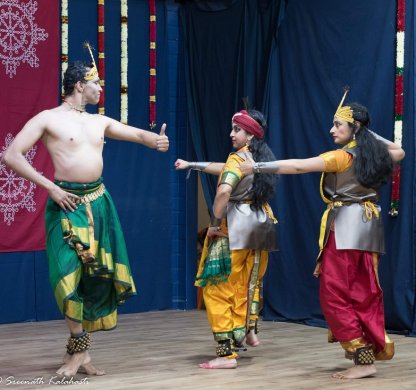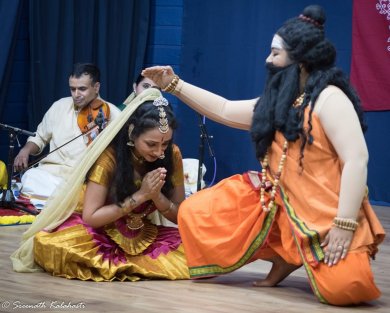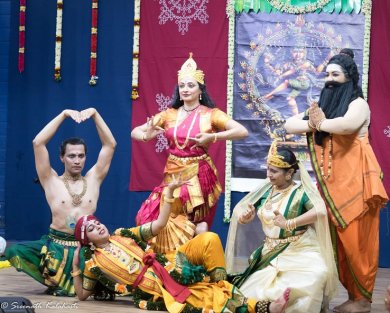
|   |

|   |
Karna Rasayana and the Natyashastra - Poornima Ramaprasad e-mail: poornima@sbcglobal.net Photos: Sreenath Kalahasti August 10, 2019 na tat jnanam na tat shilpam na saa vidyaa na saa kalaa | naasau yogo na tat karma naatye asmin yanna drishyate || There is no knowledge, no sculpture, no wisdom, no art, no connection or no action that is not found in the performing arts - says the Natyashastra. The journey of studying Natyashastra as a cohort group (NS101) for over 6 months, even though we were just able to tread knee deep and not really swim in it, was quite fulfilling. We are that much better rasikas, with that much more respect for artists and scholars and that much more love for the art forms. It is humbling, to say the least, and truly unbelievable that Bharata, the creator of the Natyashastra, has thought through so extensively some 2 millennia ago about what works best for the masses, how the stage should look, what is expected of each type of actor, so on and so forth. He must have seen hundreds of such performances before his time to be able to do such critical analysis. Karna Rasayana, the dream project of NS101, under the banner of Mandaara Creations, started with the intention of using a musical and doing a lec-dem of Natyashastra for friends and art patrons. We were looking for a poetry that has chandaas (prosody), is in Kannada, simple to understand and lends itself for singing and dancing - which other poem other than Kumaravyasa's Gadugina Bharata would fit the bill? This poetry is in the prosody called Bhamini Shatpadi, which is unique to Kannada. A biographical presentation of Karna, from his birth to his death in the Kurukshetra war was perfect for our intention. As always, the ever inquisitive, super supportive Bay Area art connoisseurs welcomed the idea wholeheartedly. Sanatana Dharma Kendra in San Jose, which is a strong promoter of performing arts in the Bay Area provided venue. The hall was jam packed and the guests contributed to a pledge drive conducted for the benefit of the temple on July 28, 2019. Kumaravyasa Bharata portrays Karna in a positive light and has made some deviations from the original in dealing with his character. Karna, who is ignored by everyone since he is a sootaputra, finds companionship in the Kaurava prince Duryodhana and becomes part of many sinful acts. Yet there is a side of Karna which is full of respect, sympathy, truthfulness and courage, which makes him come out as a brave and lovable character. The narrative of the presentation started with the poet Kumaravyasa coming on stage and writing his work Gadugina Bharata. The audience was then transported to the Dwaparayuga for the story of Karna, starting with the birth of Karna. Karna is the son of Suryadeva and princess Kunti (later the queen-mother of the Pandavas). He was conceived by means of a boon by sage Durvasa and was born to an unmarried teenage Kunti, who out of shame abandons the new born Karna in a basket on the river Ganga. Karna is then raised by Atiratha, a charioteer and befriends Duryodhana, who sees his valor and makes him the king of Anga province. During the great Mahabharata war, Krishna realizes that Karna is truly a threat to the Pandavas, and puts him in moral ambiguity to protect Arjuna, by telling him the story of his birth - that he is the first son of Kunti and that Lord Surya is his father. Karna ponders over how Suryadeva had protected him all his life.   The story continues as Kunti comes to Karna and begs him to save her sons. Karna promises that he will not fight with anyone else other than Arjuna and that she will still have five sons (either Arjuna or him). He also promises to not use the arrows that he uses once. This weakens Karna in the ensuing battle. On the seventeenth day, Karna takes the leadership for the Kaurava army and a fierce battle ensues between him and Arjuna when there is a moment when Karna's chariot sinks into the ground. While he is weaponless and is working to get his chariot up, Arjuna aims the fatal shot, at the order of Lord Krishna and kills Karna. The presentation ended with a mangala verse from Kumaravyasa Bharata, to which all the dancers took a beautiful final pose of Seshashayana Vishnu with Lakshmi, Shesha, Brahma and muni. The story of Duryodhana befriending Karna, Parashurama's curse, Indra taking away the kavacha kundala, Karna staying out of war under Bhishma's leadership, since Bhishma called him 'Ardha-rati', slaying of Abhimanyu, Shalya - Karna's charioteer's argument with Karna and leaving Karna alone in the battlefield were all bridged verbally in short dialects between Sutradhara and Nati. In between scenes, a commentary about what was seen and how it should be connected to Natyashastra and comparing it to present day mass dramas and movies added a lot of educative information that the audience seemed to enjoy. The 'poorva ranga vidhi' began onstage with the musical instruments arranged and included entry of musicians, tuning instruments, prayer to the Lord - which is also the Nandi padya of Kumaravyasa Bharata. This was followed by a pushpanjali using the famous Kumaravyasa verse "Gajamukhane merevekadantane" and "Gajamukhana varamaate Gowriye" in ragas Naata and Saveri, set to misrachapu tala, for which the dancer entered the stage with the jarjara, or the Indra Dhwaja - the flagstaff of Indra which was brought out to signal to the evil influences that the Rangasthala had the protection of the gods in Bharata's scripture. In today's world, we pray to the lord to protect us from evil technical glitches! hasta paada samyogah nrttasya karanam bhavet || Karana means action and it is the perfect combined movement of the hands, feet and the sthaana (or the pose) to express something. Karanas are employed to suggest the meaning of a complex expression through dance. In the jati in pushpanjali, the dancer used some karanas in the form of various poses of Ganesha that had inherent nritta and abhinaya. Sutradhara, a term going far back as the Mahabharata, literally means 'one who holds the strings'. He, with his wife Nati, does hold the strings to the direction, the setting of the stage for the play and saying 'Lights! Camera! Action!' In the presentation, the main act took place on the Rangapeetha or the main stage. The Sutradhara and Nati mostly enacted from the front stage that is a step below and is called mattavaarini - which is frequently used in dramas for interscene comic relief or for filling the gap in the main story when time lapse or location change has to be shown on the main stage. In this presentation, the acts that needed to progress Karna's life but were not enacted on main stage were briskly told as vyaakhyaana by the Sutradhara-Nati couple. All the characters on the main stage enacted in Natyadharmi or stylistic presentation and the characters on the mattavaarini used Lokadharmi or a more colloquial acting style. Kunti entered the stage from behind a small screen called the javanike which was held by the Sutradhara and Nati. There's a fine art to ensuring that an important character makes an instant impact on screen or stage. Isn't it so impactful when Aishwarya Rai slowly skulks her way into the shot? Here, Kunti entered behind the screen as a teaser, the javanike was then taken away as Kunti danced to a merry tune in Brindavani raga bringing merriment and an overall sthayi bhava of happiness. naatyam bhinnarucherjanasya bahudhaapyekam samaaraadhanam | Dance or drama is a means of pleasing people of different tastes, says Kalidasa. There has to be an entertaining element for the masses. Song and dance sequences on nature are always a hit with the masses. This presentation had a song/dance solo by the young princess Kunti, who feels excited and happy when Sage Durvasa gives her the mantras to bear children. The song 'Pasarisitu madhumaasa' is a famous verse in the Kumaravyasa Bharata about spring and was set in Amritavarshini raga to misrachapu tala. Such verses are ideally adapted to any joyous scene to celebrate the season, and is called Prakruti Dhruva. The Bhamini Shatpadi meter renders itself to misrachapu tala. This only reiterates why Bollywood creates dream sequences where our superstars get transported from their living room to Switzerland in the blink of an eye and break into romantic songs and dances amidst the rolling hills and flowering valleys. Well, that is what we rasikas want, as a break from the narrative. In the next scene, Krishna was introduced to the stage with a dhruva called the Pravesha dhruva. An iconic entrance emphasises a character's importance and helps to cement their influence over the rest of the play. Does that ring a bell now as to why Dr. Raj Kumar or Rajanikanth burst into the scene in a flurry of noise or to a song praising their greatness? Bharata, the king of the masses, knew that too. Here, Krishna zoomed into the stage with a fast paced song in Arabhi raga, set to adi tala, with jati, swara and sanchari, describing his greatness in the Govardhana giri episode, Draupadi episode and that he is the incarnation of Vishnu who has taken Dashavataras for the welfare of mankind. The next part was acted out to Kavyavaachana style elaborated singing of the verses. A beautiful combination of mood appropriate ragas was used for the verses including Poorvikalyani, Malayamaaruta, Charukeshi among others. Abhinaya is the most important topic in performing arts. It comprises of angika where movements of the limbs are used, vaachika where words are used, aaharya where costumes and scenery are used and saatvika where expressions are used. In the tete-e-tete between Krishna and Karna, which was acted to Kavyavaachana, all the four kinds of abhinaya were explained. - Krishna rode the chariot to meet Karna using angika abhinaya with gestures showing a chariot movement - Krishna spoke to Karna in real words - which qualifies as vaachika abhinaya - Without even actually telling, you would know it was Krishna by his attire (the peetaambara and the peacock feather), so that is the aaharya abhinaya - The emotional turmoil displayed between Krishna and Karna was spot-on saatvika abhinaya. A good blend of all these made for good acting and easy interpretation for the audience. The next song was a Surya Kavithvam in the ragas Vasantha and Kanada, set to rupaka tala, which Karna sings in praise of Lord Surya, who, he comes to know, is his father and somehow, had thus far been protecting him. This solo dance established Karna as a strong character and the artist playing Karna as a good dancer and actor. The rasa theory - perhaps one of the greatest contributions of Bharata, explains the concept of rasa and how it is generated. vibhaava-anubhaava-vyabhichaari samyogaa-d-rasa nishpattih || VIBHAAVA---causes--->BHAAVA---causes--->ANUBHAAVA--->RASA In the scene between mother Kunti and Karna, which was enacted to Kavyavaachana elaboration, Kunti tells Karna about his birth secret, which is the Vibhaava. Vibhaava literally means the determinant or the cause. Karna and Kunti both cry at each other's helplessness and responsibilities that bind them, which becomes the Anubhaava. Anubhaava refers to the impact or the consequence of the vibhaava. This leads to grief and dejection in Karna who says he is bound by his loyalty to Duryodhana, which becomes the Bhaava. The scene ends in the sthaayi bhaava of shoka on stage, leading to the evoking of Karuna rasa in the audience. When audience cry or laugh or even get angry at the characters when warranted, the production has achieved Siddhi or success. For the rasa to be conveyed as desired, the vibhaava, bhaava and anubhaava should be aligned well. The ensuing battle scene was in a style called Arabhati vritti which is energetic and depicts valour. It was the very personification of the utsaha sthaayi to evoke the veera rasa. Bharata has mentioned that disturbing scenes such as death and war scenes must not be shown. But he has also said that allowances can be made and that changes and adaptations according to time and audience are essential! The battle was done to an elaborate jati pattern, set to adi tala which was sung three times, to show different astras or weapons. When Karna picked the Agni astra, Arjuna picked Varuna. The dancers became the astras at times and shifted as the archers at other times. When the sarpastra was taken, Krishna feared Arjuna's death and just pushed his chariot down, so the sarpastra took away Arjuna's crown. All this was shown in a very high energetic style and it was Arabhati vritti all the way. The rendering of jatis, the heavy mridangam accompanied with nattuvangam along with certain hand held special effects and with the violin playing Punnagavaraali raga gave a great feeling of the sarpastra and the war. Many a rasika said, they felt like they were in the battle field - such was the energy. Lo and behold - dharma prevailed; Karna fell at the feet of Krishna as he was dying. Krishna himself saluted Karna and blessed him. The art forms are very well suited in showing that dharma triumphs, and the pursuit of purusharthas - dharma, artha, kama and ultimately moksha through righteous means is what ultimately matters. Kumaravyasa Bharata is a gem in Kannada literature that every one of us must be proud of.   Ramya Abhijit took the stage as Krishna. She excelled in her abhinaya and became Krishna to the audience even after the show ended. She also was the narthaki for the pushpanjali, in which she incorporated karanas in the jatis. Ganesh Vasudeva was on the title role of Karna. He also was the kavi Kumaravyasa in the first scene. His strong nritta in the Surya Kavithvam and the battle and his mature abhinaya alongside Krishna and Kunti proved that he is a fine dancer. Chinmayi Bettadapur played the role of young princess Kunti as well as Arjuna in the battle and proved her versatility. Her presentation as young Kunti was truly an eye candy. Monika Venkateshmurthy's abhinaya as elderly Kunti and her support on the nattuvangam for the war jati were perfect. Smitha Ram as Durvasa did a wonderful job on stage. Stage play, music composition and direction were by Ramaprasad KV, with lyrics for some songs from Kumaravyasa Bharata and some self written. He also did the Kavya vaachana using appropriate ragas for each of the verses. Shlagya Vasistha on vocals was a pleasure to listen to. She was aptly supported by S N Narasimhan on the violin and Nikhila Radhakrishna on the flute. Sanjeev Palamand on the mridangam was excellent. His special effects including certain side instruments, his use of nadais for various sancharis in the songs and in the war truly enhanced the viewing experience. The jati for the battle was composed by Ganesh Vasudeva. The roles of commentator, Nati and Sutradhara provided appropriate interruptions to enable the audience to advance the story of Karna while being able to understand the concepts of Natyashastra. The audience was very appreciative of this extra education alongside entertainment. rasā bhāvāhya abhinayāḥ dharmī vṛtti pravṛttayaḥ siddhiḥ svarās tathā atodyaṃgānaṃ raṅgaśca saṅgrahaḥ The success (Siddhi) of a play enacted on the stage (Ranga) with the object of arousing joy (Rasa), in the heart of the spectators involves various elements like the actors' gestures (bhaava); bringing forth their intent (abhinaya), through the medium of theatrical and common practices (dharmi - or per their dharma); in different styles of representations (vritti); with the aid of melodious songs and instrumental music (svara-gana-atodya). We tried to briefly explain all of the above to the best of our ability. As a way to understand siddhi, we had a camera recording the audience sections randomly to study the 'Rasaanubhava' and were happy to find that, many in the audience were connecting with the actors and reacting to the rasas on stage with very apt expressions and tears! And it is again amazing that Bharata has names for every kind of reaction in his text! The culmination of a 7 month long study of the Natyashastra was much to our satisfaction, a resolution made on New Year's day achieved Siddhi, so to say. If any individual or group is interested in studying the Natyashastra, NS101 will be very happy to provide an overview of our plan. We are thankful for live lectures by experts Dr. Shatavadhani R Ganesh, Dr. Tulasi Ramachandra and Vidya Ram. We also had lecture-demonstrations by the members of the cohort, along with self study and discussion topics. yatho hastasthatho drishtih | yatho drishtisthatho manah yatho manasthatho bhaavah | yatho bhaavasthatho rasah Acknowledgements: Natyashastra by Adya Rangacharya, Online blogs on the topic, Pratap Simha, Vasudha Hegde. Poornima Ramaprasad follows Indian classical music and dance forms. She reviews Indian dance and drama events in the San Francisco Bay area from time to time. |